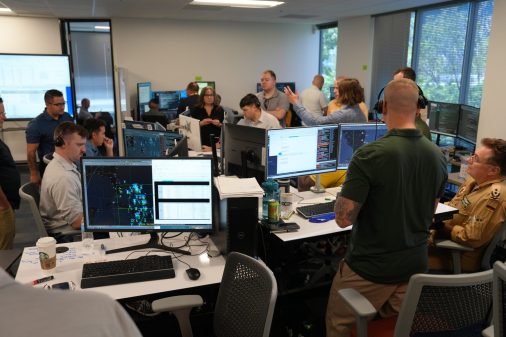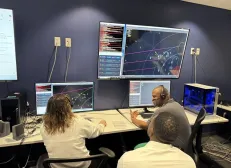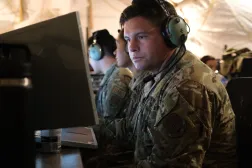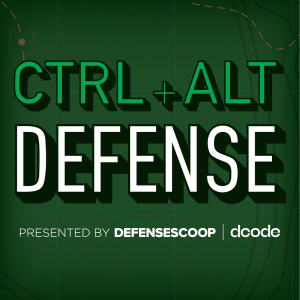Air Force experimenting with AI microservices during new battle management wargame series
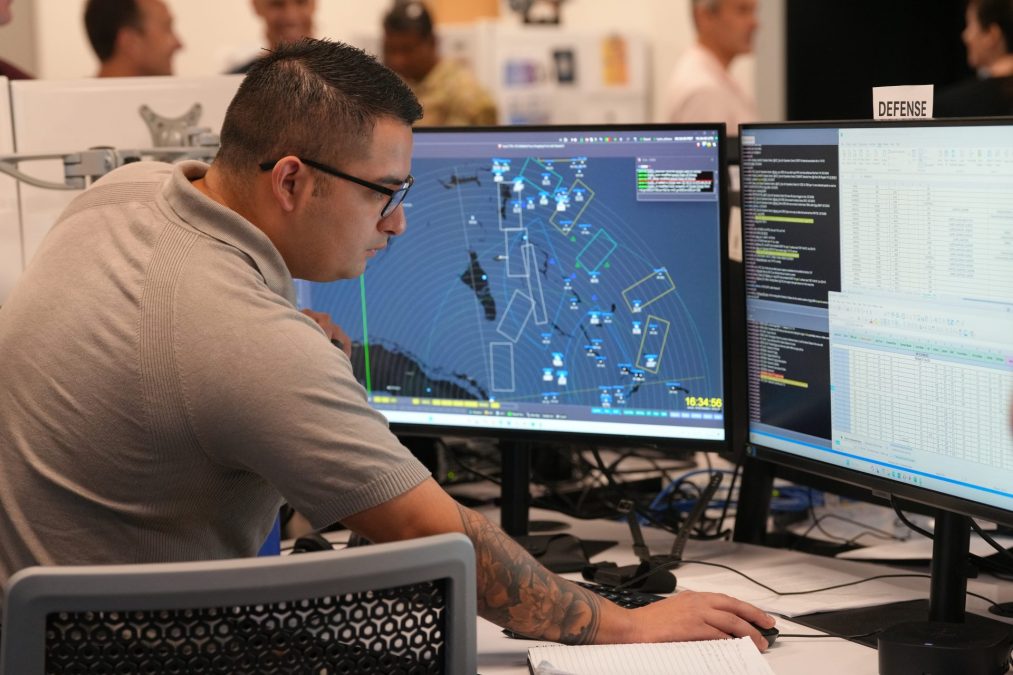
This is part two of a three-part series examining how the Air Force is experimenting with artificial intelligence for its DAF Battle Network capability. It is based on several exclusive interviews with the 805th Combat Training Squadron, the Advanced Battle Management System Cross Functional Team, airmen and members of industry. Part one can be found here.
NELLIS AIR FORCE BASE, Nev. — The Air Force is jetting ahead with a new experimentation campaign to test how industry-developed artificial intelligence and machine learning software can be integrated into the service’s battle management operations.
Hosted by the 805th Combat Training Squadron, the Decision Advantage Sprint for Human-Machine Teaming (DASH) wargames are two-week events where the Air Force invites teams from industry and the service to build and test AI-enabled battle management software. The experiments seek to aid development of the Air Force’s contribution to Combined Joint All-Domain Command and Control, known as DAF Battle Network, but officials told DefenseScoop the DASH events are also fostering closer collaboration between the service and its vendors.
The 805th — known as the Shadow Operations Center – Nellis (ShOC-N) — kicked off the DASH series earlier this year as a complementary effort to the squadron’s biannual human-machine teaming capstone series. While the capstones are designed to test near-term AI capabilities for Air Combat Command, the DASH experiments are exploring technologies and concepts for the future state of C2, ShOC-N Commander Lt. Col. Shawn Finney told DefenseScoop.
“Think of it as two parallel efforts. They’re aware of each other, but they’re also eyeballing and looking to make sure they’re informing each other,” Finney said in July during a tour of the 805th’s operations floor.
The DASH sprints are held at the ShOC-N’s unclassified office space in Las Vegas, Nevada, lowering the barrier of entry for which industry teams can participate. Each event focuses on a single subfunction from the Air Force’s Transformational Model for Decision Advantage, a methodology that breaks down the command and control cycle into each individual decision a battle manager makes during operations.
“We’re not focused on the quantity of data, we’re not focused on the bandwidth or how many communication pathways. We’re physically … stressing the battle managers into making decisions, and then having companies observe what they’re doing and then trying to develop microservices that improve the cognitive load to shift from the human to the computer,” Col. John Ohlund, director of the Advanced Battle Management System Cross Functional Team, said in an interview.
During the experiments, the Air Force simulates an operational scenario solely focused on one of the transformational model’s subfunctions — asking questions such as “Is this object of interest a target?” or “What is the best weapon to destroy that target?”
Air battle managers will first run through the scenario with the tools they regularly use at their home stations, giving the Air Force a baseline to test against and vendors an opportunity to understand capability needs. Then, industry teams spend two weeks writing AI-enabled software to assist battle managers in making faster, more informed decisions.
Throughout the experiment, industry teams routinely stress-test their software through other operational wargames that resemble the Air Force’s baseline, allowing them to see how the code responds to slightly different scenarios or unanticipated variables. These periods are a key part of the experiment’s success, as vendors receive real-time feedback from operators before their final presentations.
The close collaboration during the DASH experiments is also resolving language gaps between the Air Force and industry participants, Lt. Col. Wesley Schultz, ShOC-N’s director of operations, said in an interview. He noted that in the past, vendors would try to pitch battle management solutions that weren’t informed by a battle manager — and thus fell short of what exactly the Air Force needs.
“What this does is gives us the ability to speak the same language, because we’re deriving requirements that are engineer-informed, or informed by battle management but then written by an engineer,” Schultz said.
Finney noted that conversations between air battle managers and industry have covered a range of things during the two DASH sprints the squadron has completed this year. Sometimes, vendors will ask airmen to explain different codenames and data coming through a chat log or the headset. Other times, questions will be as simple as what the specific roles for each battle management crew member are.
At the end of the two-week experiment, the ShOC-N analyzes their results and shares them with the ABMS CFT and other Air Force leaders, who will use the findings to hopefully develop requirements for an AI microservice for the specific subfunction.
“We’re trying to give objective data [and] quality decisions back to senior leaders,” Finney said. “What I mean by that is, we can objectively prove not that vendor A is better than vendor B, but simply that the process was better.”
He added that the constant communication between the test and acquisition communities is significantly reducing procurement timelines, giving the Air Force space to keep up with industry advancements in software.
The DASH wargames are proving that artificial intelligence can effectively improve the Air Force’s C2 enterprise. Throughout the experiments, officials have seen industry’s software help operators understand the scenario they’re in and present data and solutions at a much faster pace than normal — augmenting the human’s ability to make better decisions overall.
“War and conflict is a quantum problem, but we can’t solve quantum problems,” Schultz said. “What we can do is have other things help us reduce the noise and reduce the amount of things we have to consider, and that’s how we get closer to success in a quantum-type problem.”
At the same time, the events are giving insights into the current limitations of AI and what the service needs to consider when implementing it. For example, some experiments presented inaccurate decisions because the Air Force did not provide variables for weather — something a human would automatically consider during operations, but an algorithm needs to be trained on, Finney said.
Continued refinement of that human-machine team will be the focus of the DASH wargames moving forward. The squadron has one more planned for 2025, and hopes to complete four in 2026.
In the near term, the ShOC-N will test one subfunction under the transformational model per DASH sprint. But officials said future events could combine multiple microservices together to ensure they all work together without affecting overall performance.
“We look at it as true experimentation. In a test, people go in expecting to pass. We go in expecting to unlock new things, to continue experimentation,” Schultz said. “I think that’s largely what allows us to do things a little differently and maybe move the ball a little further, faster, to get it to those folks who then make sure it’s ready for operations.”
